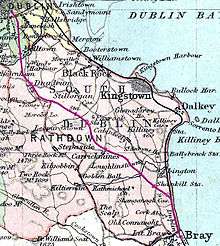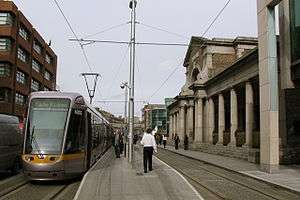Harcourt Street railway line
| Harcourt Street line | |||||||||||||||||||||||||||||||||||||||||||||||||||||||||||||||||||||||||||||||||||||||||||||||||
|---|---|---|---|---|---|---|---|---|---|---|---|---|---|---|---|---|---|---|---|---|---|---|---|---|---|---|---|---|---|---|---|---|---|---|---|---|---|---|---|---|---|---|---|---|---|---|---|---|---|---|---|---|---|---|---|---|---|---|---|---|---|---|---|---|---|---|---|---|---|---|---|---|---|---|---|---|---|---|---|---|---|---|---|---|---|---|---|---|---|---|---|---|---|---|---|---|---|
|
Harcourt Street terminus on the right, by George Wilkinson, 1858-59. | |||||||||||||||||||||||||||||||||||||||||||||||||||||||||||||||||||||||||||||||||||||||||||||||||
| Overview | |||||||||||||||||||||||||||||||||||||||||||||||||||||||||||||||||||||||||||||||||||||||||||||||||
| Type |
Commuter rail, Inter-city rail Heavy rail | ||||||||||||||||||||||||||||||||||||||||||||||||||||||||||||||||||||||||||||||||||||||||||||||||
| System | CIÉ Railways Division | ||||||||||||||||||||||||||||||||||||||||||||||||||||||||||||||||||||||||||||||||||||||||||||||||
| Status | Not in use | ||||||||||||||||||||||||||||||||||||||||||||||||||||||||||||||||||||||||||||||||||||||||||||||||
| Locale | Ireland | ||||||||||||||||||||||||||||||||||||||||||||||||||||||||||||||||||||||||||||||||||||||||||||||||
| Termini |
Harcourt Street Bray Daly | ||||||||||||||||||||||||||||||||||||||||||||||||||||||||||||||||||||||||||||||||||||||||||||||||
| Stations | 10 | ||||||||||||||||||||||||||||||||||||||||||||||||||||||||||||||||||||||||||||||||||||||||||||||||
| Operation | |||||||||||||||||||||||||||||||||||||||||||||||||||||||||||||||||||||||||||||||||||||||||||||||||
| Opened | 10 July 1854 | ||||||||||||||||||||||||||||||||||||||||||||||||||||||||||||||||||||||||||||||||||||||||||||||||
| Closed | 31 December 1958 | ||||||||||||||||||||||||||||||||||||||||||||||||||||||||||||||||||||||||||||||||||||||||||||||||
| Owner | CIÉ Railways Division | ||||||||||||||||||||||||||||||||||||||||||||||||||||||||||||||||||||||||||||||||||||||||||||||||
| Operator(s) | CIÉ Railways Division | ||||||||||||||||||||||||||||||||||||||||||||||||||||||||||||||||||||||||||||||||||||||||||||||||
| Character | Tertiary | ||||||||||||||||||||||||||||||||||||||||||||||||||||||||||||||||||||||||||||||||||||||||||||||||
| Rolling stock | CIÉ 2600 Class | ||||||||||||||||||||||||||||||||||||||||||||||||||||||||||||||||||||||||||||||||||||||||||||||||
| Technical | |||||||||||||||||||||||||||||||||||||||||||||||||||||||||||||||||||||||||||||||||||||||||||||||||
| Line length | 12.5-mile (20 km) | ||||||||||||||||||||||||||||||||||||||||||||||||||||||||||||||||||||||||||||||||||||||||||||||||
| Number of tracks | Double track | ||||||||||||||||||||||||||||||||||||||||||||||||||||||||||||||||||||||||||||||||||||||||||||||||
| Track gauge | 1,600 mm (5 ft 3 in) Irish gauge | ||||||||||||||||||||||||||||||||||||||||||||||||||||||||||||||||||||||||||||||||||||||||||||||||
| Electrification | Not electrified | ||||||||||||||||||||||||||||||||||||||||||||||||||||||||||||||||||||||||||||||||||||||||||||||||
| |||||||||||||||||||||||||||||||||||||||||||||||||||||||||||||||||||||||||||||||||||||||||||||||||
The Harcourt Street railway line (Irish: Seanlíne Iarnróid Shráid Fhearchair) ran from Harcourt Street in Dublin through the southern suburbs to Bray.
History
Following the success of the Dublin and Kingstown Railway (D&KR), which opened on 17 December 1834, proposals for a second commuter railway were put forward. These plans proposed the building of a 12.5-mile (20 km) railway from Bray Daly, which opened on 10 July 1854 to initially terminate at Harcourt Road. (Harcourt Street Station was not built until 1859). The building of the line was done by two railway companies: The Dublin, Wicklow and Wexford Railway (DW&WR), who built the line from Dundrum to Bray and the Dublin, Dundrum and Rathfarnham Railway (DD&RR), who were to build the line from Harcourt Street to Dundrum. The latter failed to do so, and the 'Dublin & Wicklow Railway' took over the line works.
On 14 February 1900, a train from Enniscorthy failed to stop and went through the buffers and the wall of the station,[1] sending debris over Hatch Street. Nobody was killed, though the driver, William Hyland, had his right arm amputated at the scene. Another serious accident occurred on 23 December 1957 when two trains collided in thick fog just south of Dundrum station. The first train had slowed to a walking pace because of a cow on the line. The second train was allowed into the same section of a track due to an error by a signalman. Its driving cab was completely destroyed in the collision and the driver, Andrew Larkin, was killed instantly.[2]
In the 1950s, diesel gradually replaced steam in an effort to improve journey times as many passengers had by then forsaken the line due to a rapid and significant increase in private car ownership. CIE were also rapidly expanding their then new bus services in and around the railway.
Route

| Harcourt Street Line | |||||||||||||||||||||||||||||||||||||||||||||||||||||||||||||||||||||||||||||||||||||||||||
|---|---|---|---|---|---|---|---|---|---|---|---|---|---|---|---|---|---|---|---|---|---|---|---|---|---|---|---|---|---|---|---|---|---|---|---|---|---|---|---|---|---|---|---|---|---|---|---|---|---|---|---|---|---|---|---|---|---|---|---|---|---|---|---|---|---|---|---|---|---|---|---|---|---|---|---|---|---|---|---|---|---|---|---|---|---|---|---|---|---|---|---|
Legend | |||||||||||||||||||||||||||||||||||||||||||||||||||||||||||||||||||||||||||||||||||||||||||
| |||||||||||||||||||||||||||||||||||||||||||||||||||||||||||||||||||||||||||||||||||||||||||
The 12.5-mile (20 km) route ran south, initially from a temporary terminus on Harcourt Road, serving the intermediate stations of Dundrum, Stillorgan, Carrickmines and Shankill. The new Harcourt Street station, still extant, opened on 7 February 1859, along with a temporary platform at Foxrock.
Further new stations followed; Milltown (1860), Foxrock (1861), Rathmines & Ranelagh (1896, renamed Ranelagh in 1921). It joined the Westland Row line at Shanganagh Junction continuing to Woodbrook Halt (1910), which served the cricket ground on Sir Stanley Cochrane's estate. The Woodbrook Golf Club and Cricket Grounds later used this halt between 1920 and 1960. In October 2015, it was proposed to reopen Woodbrook as a station on the DART line between Shankill and Bray.
One of the major engineering feats on the line was the Milltown Viaduct, or Nine Arches, which still stands today over the River Dodder.
-

The crash of 1900
-

Harcourt St. station, c. 1910
-

The up platform at Dundrum Station complete with a sign for St Columba's College on the signal box.
-

The Nine Arches Bridge as shown in a 1909 postcard.
Decision to close

Following the Beddy Report of 1957, CIÉ began to realise that in an effort to save money, all the non-profitable rural railway branch lines would have to close. The Harcourt Street line was one of these unprofitable railway lines and so the decision to close the line was ultimately reached. In October 1958, CIÉ gave notice of the closure in the local papers. Many objections were raised by local people but to no avail. The last train, CIÉ 2600 Class AEC railcar number 2652, left Harcourt Street at 4:25pm on 31 December 1958. One interesting event that occurred was that when this train began crossing The Nine Arches Viaduct between Milltown and Dundrum, the staff of the nearby laundry turned out in force and blew sirens as the train crossed the viaduct for the last time. Following the closure, many of the stations were sold by public auction. The tracks were lifted between 1 January 1959 and September 1960.
Legacy
The route was preserved after closure, allowing for a potential future reopening. The route corridor remained mostly in-situ until the 2000s. The section between the Grand Canal crossing and the old Stillorgan station was chosen for use by the Luas light rail system whose Green Line opened in 2004. The line crosses Dundrum on the new William Dargan cable-stayed bridge.
An extension of the Luas to Cherrywood opened for passenger service on Saturday 16 October 2010, using most of the old railway alignment.[3][4][5] The route leaves the old alignment after Sandyford Depot to Central Park stop, crosses the M50 motorway and runs down Ballyogan Road with stops at Glencairn, The Gallops, Leopardstown Valley and Ballyogan Wood. It then crosses the M50 again, re-joining the original alignment at Racecourse (future) stop, west of Glenamuck Road. Continuing along the alignment it passes by the original Carrickmines station to Carrickmines stop and Brennanstown (future) stop. The Carrickmines stop incorporates Park and Ride facilities. The RPA has announced that the Brennanstown stop will not be opened due to lack of local development.[6] Beyond Brennanstown the route crosses open countryside, diverging slightly from, but paralleling the old alignment to Laughanstown stop, Cherrywood stop and ending at Bride’s Glen stop, adjacent to Dell.
The final extension to Fassaroe[7][8] will continue on the old alignment to Loughlinstown, just 1mile (1.5 km) short of the old Shanganagh Junction, before finally leaving the old route by turning south and paralleling the M11.
Visible remains
Several bridges, stations and much of the alignment have survived. These include the Harcourt Street Station, Dundrum, Stillorgan, Carrickmines and Shankill stations, Woodbrook Halt, the Nine Arches and Bride's Glen viaducts. No trace of Foxrock station remains as the building was demolished in 1991, other than the original passenger entrance to Leopardstown Racecourse beside the golf club main gates.
-
Bride's Glen Viaduct
-

Carrickmines Station. The passenger access ramp, waiting room & the modern extension to the rear were demolished as part of the LUAS works.
-

Stillorgan Station, now a private residence
-

The Nine Arches Viaduct
-

Dundrum Railway Station, restored and converted to a coffee shop in March 2011.
-

The new Sandyford Luas depot on the left & the old Stillorgan Station building, now a private residence, on the right. The line ran through the centre of the picture
-

Shankill Station, to rear of modern office addition
Trivia
- Mile posts on the Dublin - Wexford railway line, south of Shanganagh Junction, are still measured from Harcourt Street.
See also
References
- ↑ http://www.harcourtstreettraincrash.com/
- ↑ http://www.railwaysarchive.co.uk/documents/Unk_Dundrum1957.pdf
- ↑ Sandyford to Cherrywood, Line B1 info
- ↑ Line B1 simple maps
- ↑ Line B1 Railway Order, Environmental Impact Statement & detailed maps
- ↑ Irish Times, 14 Nov 2009
- ↑ Line B2 info
- ↑ Line B2 simple map & branch line options
- Johnson, Stephen (1997). Johnson's Atlas and Gazetteer of the Railways of Ireland. Midland Publishing Ltd. ISBN 1-85780-044-3.
- Mac Aongusa, Brian (2003). The Harcourt Street Line - Back on Track. Curragh Press. ISBN 1-85607-907-4.
